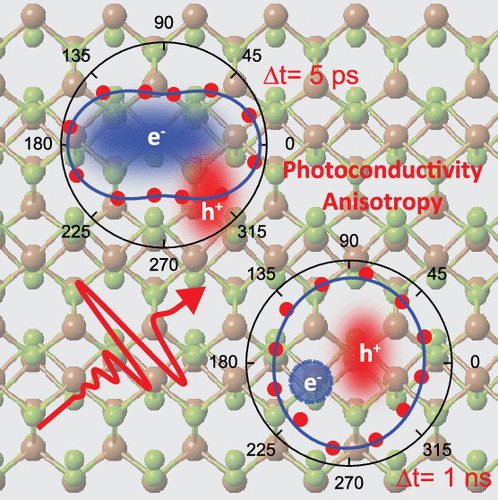当前位置:
X-MOL 学术
›
J. Phys. Chem. Lett.
›
论文详情
Our official English website, www.x-mol.net, welcomes your
feedback! (Note: you will need to create a separate account there.)
Ultrafast Anisotropic Evolution of Photoconductivity in Sb2Se3 Single Crystals
The Journal of Physical Chemistry Letters ( IF 4.8 ) Pub Date : 2022-06-01 , DOI: 10.1021/acs.jpclett.2c01346 Huijie Liu 1 , Geying Luo 1 , Haoran Cheng 1 , Zhangqiang Yang 1 , Zhaoxiong Xie 1 , Kelvin H L Zhang 1 , Ye Yang 1
The Journal of Physical Chemistry Letters ( IF 4.8 ) Pub Date : 2022-06-01 , DOI: 10.1021/acs.jpclett.2c01346 Huijie Liu 1 , Geying Luo 1 , Haoran Cheng 1 , Zhangqiang Yang 1 , Zhaoxiong Xie 1 , Kelvin H L Zhang 1 , Ye Yang 1
Affiliation

|
The antimony chalcogenide crystals are composed of quasi-one-dimensional [Sb4X6]n ribbons, which lead to strong anisotropic optical and electronic properties. An attempt to exploit photoconductivity anisotropy in the device fabrication may introduce a rewarding strategy to propel the development of the antimony chalcogenide solar cells. To achieve this, understanding of the dynamic evolution of the photoconductivity anisotropy is required. Here, the photoconductivities along different lattice directions in an antimony selenide single crystal are investigated by time-resolved terahertz spectroscopy. We find that electron trapping results in a variation of the photoconductivity anisotropy accompanied by a decrease in the photoconductivity magnitude, while electron–hole recombination only reduces the magnitude but does not affect the anisotropy. Therefore, measuring the temporal evolution of photoconductivity anisotropy can provide a wealth of information regarding the nature of the photocarrier and also render a probe to selectively evaluate the photoconductivity decay mechanisms.
中文翻译:

Sb2Se3 单晶中光电导率的超快各向异性演化
锑硫属化物晶体由准一维 [Sb 4 X 6 ] n带,导致强烈的各向异性光学和电子特性。在器件制造中利用光电导各向异性的尝试可能会引入一种有益的策略来推动锑硫属化物太阳能电池的发展。为此,需要了解光电导各向异性的动态演变。在这里,通过时间分辨太赫兹光谱研究了硒化锑单晶中沿不同晶格方向的光电导率。我们发现电子俘获导致光电导各向异性的变化伴随着光电导幅度的降低,而电子 - 空穴复合仅降低幅度但不影响各向异性。所以,
更新日期:2022-06-01
中文翻译:

Sb2Se3 单晶中光电导率的超快各向异性演化
锑硫属化物晶体由准一维 [Sb 4 X 6 ] n带,导致强烈的各向异性光学和电子特性。在器件制造中利用光电导各向异性的尝试可能会引入一种有益的策略来推动锑硫属化物太阳能电池的发展。为此,需要了解光电导各向异性的动态演变。在这里,通过时间分辨太赫兹光谱研究了硒化锑单晶中沿不同晶格方向的光电导率。我们发现电子俘获导致光电导各向异性的变化伴随着光电导幅度的降低,而电子 - 空穴复合仅降低幅度但不影响各向异性。所以,











































 京公网安备 11010802027423号
京公网安备 11010802027423号